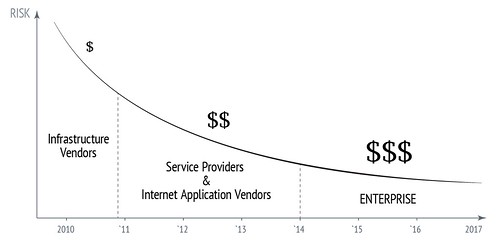Three OpenStack Predictions for 2014
Its the end of the year and everyone is getting into the fortune-telling business. As an OpenStack insider, I wanted to join the party, so here are some predictions of my own:
1. Enterprise adoption of OpenStack will take off
During the 2011 OpenStack summit, I shared my views on "who will spend money on OpenStack," depicting the adoption curve as follows:

As we edge closer to 2014 we are seeing increasing interest in OpenStack from traditional enterprises, so I'm happy to stand by my prediction of almost two years ago, and I look forward to 2014.
In and of itself predicting increasing enterprise OpenStack adoption may not be an incredibly "exciting" prediction, but the key use case behind OpenStack adoption is of far more interest.
Enterprises want the ability to perform software engineering by Web 2.0 standards. In other words, enterprises want to have an integrated DevOps environment which allows for the faster movement of features from development to production. I won't go into much more detail here, but this blog about PayPal's use of OpenStack and my webcast with Webex illustrate my thoughts. In short, OpenStack is essential to enterprises reaching their development goals because it is the only solution that allows one to federate diverse infrastructure pools into a single, integrated cloud environment. The desire of enterprises to liberate their infrastructure from vendor lock-in and to take greater advantage of their existing infrastructure investments is what will propel OpenStack ahead of the alternatives.
2. OpenStack-native PaaS will become real
There was some controversy in the infrastructure industry resulting from our speculation earlier this year that OpenStack will eventually produce a native PaaS solution threatening the likes of Cloud Foundry and OpenShift. Yet shortly after our speculation, project Solum - a native PaaS for OpenStack - was launched. No worries, "Solum is Golum" the community said. Well, it appears that Solum is the most actively discussedOpenStack-related project on stackforge, with Rackspace, IBM, Red Hat, DreamHost, AT&T, HP and others all actively participating.
This is not surprising, a native PaaS solution is critical to the "integrated DevOps environment" I mentioned in my first prediction. Indeed, not only is OpenStack-native PaaS here to stay (and displace Cloud Foundry and Openshift), but it will play a key role in propelling OpenStack towards mainstream enterprise adoption. Without it, OpenStack in the enterprise is a solution in search of a problem.
3. The OpenStack ecosystem will be rearranged
My final prediction is that we'll start seeing signs of rearrangement and consolidation in the OpenStack ecosystem. Some companies will get acquired, while some others will get acqui-hired. It's been three years since OpenStack became sexy and investors started pouring money into OpenStack startups, and now some of those startups are running out of steam.
This post was originally published by VMblog.com.






